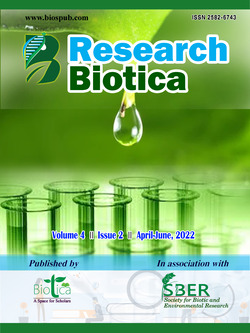
Adaptability of Macrophomina phaseolina and Fusarium oxysporum to Different Temperature and pH Causing Stem-Root Rot and Wilt Diseases of Jute
D. Mahato*
Dept. of Plant Pathology, Institute of Agriculture Science, Siksha ‘O’ Anusandhan University, Bhubaneswar, Odisha (751 003), India
DOI: https://doi.org/10.54083/ResBio/4.2.2022/33-36
Keywords: Fusarium oxysporum, Jute, Macrophomina phaseolina, pH, Temperature
Abstract
In order to ascertain the impact of physiological parameters like temperature and pH on growth and sporulation of M. phaseolina and F. oxysporum, causing stem-root rot and wilt diseases of jute, an experiment was conducted to examine. It was discovered that Fusarium oxysporum thrived at pH 5 (80.135 mg) while Macrophomina phaseolina grew best at neutral pH, or pH 7 (69.065 mg). M. phaseolina grows best at temperatures ranging from 35 °C to 30 °C, with no growth observed at lower temperatures. Fusarium oxysporum's growth peaked at 25 °C (90.00 mm), and it significantly decreased below 15 °C and above 40 °C. In response to changes in temperature, fungal development slows.
Downloads
not found
Reference
Abawi, G.S., Corrales, M.A.P., 1990. Root rots of beans in Latin America and Africa: Diagnosis, Research Methodologies and Management Strategies. CIAT, Cali, Colombia. p. 35.
Akhtar, K.P., Sarwar, G., Arshad, H.M.I., 2011. Temperature response, pathogenicity, seed infection and mutant evaluation against Macrophomina phaseolina causing charcoal rot disease of sesame. Archives of Phytopathology and Plant Protection 44(4), 320-330. DOI: 10.1080/03235400903052945.
Anonymous, 2013. Annual Report. Central Research Institute for Jute and Allied Fibres, Barrackpore, Kolkata. p. 157.
Bhupathi, P., Theradimani, M., 2018. In vitro studies of carbon, Nitrogen sources and pH on mycelia growth Blackgram Root rot caused by Macrophomina phaseolina. The Pharma Innovation Journal 7(6), 33-35.
Chowdary, N.B., Govindaiah, 2007. Influence of different abiotic conditions on the growth and sclerotial production of Macrophomina phaseolina. Indian Journal of Sericulture 46, 186-188.
Csöndes, I., Cseh, A., Taller, J., Poczai, P., 2012. Genetic diversity and effect of temperature and pH on the growth of Macrophomina phaseolina isolates from sunflower fields in Hungary. Molecular Biology Reports 39(3), 3259-69. DOI: 10.1007/s11033-011-1094-6.
Daami-Remadi, M., El Mahjoub, M., 2004. Appearance in Tunisia of Fusarium oxysporum f. sp. tuberosi causing vascular wilting and tuber dry rot of potato. Bulletin of EOPP/EPPO 34, 407-411.
Ehsan, U.H., Shakir, A.S., Sahi, S.T., 1998. In vitro studies on physiology and chemical control of fungi isolated from leaves of gladiolus in Pakistan. Pakistan Journal of Biological Sciences 1(2), 97-100.
Khamari, B., Satapathy, S.N., Roy, S., Patra, C., 2018. Adaptability of Macrophomina phaseolina, the incident of stem and root rot disease of sesame to different regime of temperature, pH and light period. International Journal of Current Microbiology and Applied Sciences 7(12), 761-766. DOI: https://doi.org/10.20546/ijcmas.2018.712.094.
Miao, W.G., Zhang, S., Fan, Y.M., Shi, D.G., Tian, F.X., 2000. Studies on the cotton Fusarium wilt pathogen with high temperature tolerance in Xinjiang. Scientia Agricultura Sinica (Synology of Agriculture) 33(2), 58-62.
Roy, A., De, R.K., Ghosh, S.K., 2008. Diseases of bast fibre crops and their management. In: Jute and Allied Fibre Updates: Production and Technology. (Eds.) Karmakar, P.G., Hazra, S.K., Ramasubramanian, T., Sinha, M.K. and Sen, H.S. CRIJAF, Barrackpore, Kolkata, India. pp. 217-241.
Sukanya, R., Ayalakshmi, S.K., Girish, G., 2016. Effect of temperature and pH levels on growth of Macrophomina phaseolina (tassi) goid. infecting sorghum. International Journal of Agriculture Sciences 8(37), 1768-1770.
Yadav, R.S., Tyagi, S., Javeria, S., Gangwar, R.K., 2014. Effect of different cultural condition on the growth of Fusarium moniliforme causing bakanae disease. European Journal of Molecular Biotechnology 4(2), 95-100. DOI: 10.13187/EJMB.2014.4.95.
